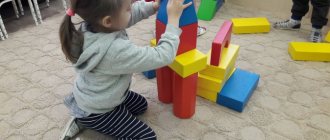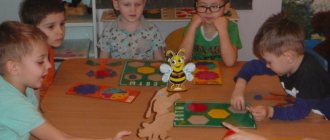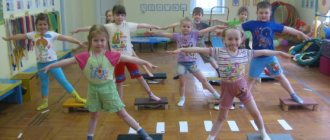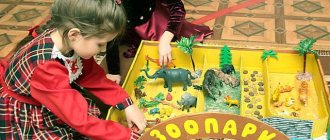What is the fastest way to learn letters with your child? The easiest way is to hang a poster with the alphabet on the wall and regularly voice it to your child... But... this method does not work for all children! Unfortunately, many children get bored very quickly and simply “run away” from such activities.
If you find yourself in such a situation, don’t despair! There are many fun letter learning games that your child will love!
Before you start learning letters, it is important not to forget:
Most preschool teachers agree that it is best to teach children the “sound” interpretation of letters (not “Ka” but “K”, not “Be”, but “B”, etc.).
This is done so that later it will be much easier for the child to learn to add syllables.
Compare in which case it will be easier for a child to “figure out” how to form a syllable:
Sound option: “B” + “A” = “BA”
Letter version: “Be” + “A” = ????? - according to the logic of things, children often want to say “BeA” in this place, and this is where the main problem arises that many parents face when they teach their children the “classical” names of letters (such as “Be” “Ve”, etc. .) - when reading syllables, it is difficult for a child to mentally discard the sound “a” from “Ka”, the sound “e” from “Ve”, etc. (they want to read not “VA”, but “VEA”, not “BU”, but “BeU”, etc.)
And this complexity becomes a serious obstacle to teaching a child the skill of combining individual letters into syllables.
Therefore, studying the “sound” interpretation of letters will be much preferable.
So:
Let's color it.
Everything is simple here! You can download coloring pages with letters from the Internet and invite your child to color them. The child will engage in creativity with interest, and at the same time consolidate knowledge about the new letter.
To prevent the child from getting bored with the coloring process, you need to use various interesting techniques:
- color letters not only with pencils, but also with paints, wax crayons, and stamps;
- paint with your fingers using finger paints;
— use non-traditional drawing techniques ( with cotton swabs, crumpled paper, blots, etc.).
2. Decorate the letter.
Children will have fun decorating the letters!
You can decorate them with plasticine, applique, colored glass, construction kit parts... whatever you want!
Try decorating the letter “A” with watermelons, the letter “B” with bananas, etc.
Electronic poster “Talking ABC”
The educational sound poster is a great addition to standard alphabet learning techniques.
It combines visual and audio perception, allowing you to learn the letters and sounds of the alphabet, as well as numbers from 1 to 33. The poster features several modes - song, riddle or task, which allows you to diversify the learning process.
The posters differ in sound and pronunciation principles. It is recommended to choose those where there is a pronunciation of letters as sounds.
Learning the alphabet is an important step in the life of every child, which will allow them to gain new knowledge and analyze it. It is worth treating this period with patience and helping your child learn through a playful approach and support.
Let's sculpt.
A very useful activity is to sculpt letters from colored dough or plasticine. And if you combine sculpting with listening to Ekaterina Zheleznova’s songs from the album “Musical Primer” (in which the whole sculpting process is “sung” in a very interesting way), then sculpting will be even more fun.
Wonderful mothers, passionate about the development of children, have long made funny videos from these songs and posted them online.
For example, while playing and watching a funny video, you can make the letter A in a fun and interesting way:
Tilt two sticks
Connect at the top
One crossbar -
Like a letter A tent!
Halves is a game to consolidate knowledge about already familiar letters.
In the process of learning the alphabet, the process of repetition is important. Still would! After all, by the time you get to “I”, you must try not to forget the letter “A”.
The process of repeating already learned material will be more fun with the game “Halves”!
Cut out beautiful cards with letters, cut them into two parts, mix them.
Invite your child to “fold” letters from two halves.
Learning letters: where to start?
Photo source – www.freepik.com
Before teaching your child letters, you need to decide: 1) whether he is ready to learn, and 2) what goal you are pursuing. If the reason lies in the parents’ desire for the child to know as much as possible in order to show off to others, it is better to leave this idea. The young student himself must show an interest in knowledge and want to learn the alphabet. You need to concentrate on his desires and abilities.
If parents see that their child is inquisitive and shows interest in new knowledge, this is a signal that they can start learning letters. It is important to remember that any theory must be supported by practice. Having learned the letters, proceed to syllables, and then gradually move on to reading.
The main task of parents is to be patient and convey information in an accessible form, and also not to force the child to study if he does not want to. It is better to conduct classes in the form of a game.
You need to start training only if the child himself wants it, or if he will soon go to school. According to the requirements of educational institutions, when entering school, children must know the basics - letters, numbers. Without these basic skills, studying will be much more difficult.
Is your child ready to learn the alphabet?
To determine how ready the baby is, there are psychological tests. Parents are asked to answer yes or no to the following questions:
Development of cognition
- Does the child understand such judgments - right/left, much/little, big/small, low/high, near/far, under/above.
- Can understand simple situations in which it is necessary to divide objects according to classification. For example, identify a group of green and red objects.
- Is he able to think of the end of a fairy tale or story?
- Does he consistently fulfill three requests, without reminding his parents?
Basic knowledge
- Has the child ever been to a post office, a store, or a zoo? How broad his horizons are.
- Have you visited the library?
- Did his parents read fairy tales to him, starting from a very early age?
Speech development
- Is it easy for the child to name the objects that surround him?
- Is it easy to answer the questions asked?
- Is he able to tell the purpose of household things - a vacuum cleaner, an iron, a refrigerator.
- Can he determine the location of objects - on, under, inside, near.
- How clearly does he pronounce words?
- Can he conduct a dialogue?
Development of the emotional sphere
- Is the child having fun with friends and communicating with family?
- Can he adapt to new changes in his daily routine?
- Knows how to compete and cooperate with friends.
Communication level
- Can he share toys and communicate with other children?
- Knows how to listen to others and not interrupt.
Level of physical development
- Is the child diligent, is he able or not to sit quietly for a certain period of time?
- Plays with the ball, jumps, goes down and up the stairs.
- Gets enough sleep, has a good appetite, and knows how to extinguish emotional outbursts.
Development of visual abilities
- Can a child distinguish between similar and dissimilar and classify them into separate groups?
- Distinguishes short words and syllables with similar sounds - forest/weight, cat/year.
- Able to notice changes - if three pictures were shown at first, and then one was removed.
- He knows how to spell his name, what at least three letters from the alphabet look like.
- According to the instructions of an adult, he is able to lay out pictures on the table.
- Knows the order of reading words - from left to right.
- Folds the minimum number of puzzles - from 10.
Hearing development
- Rhymes words.
- Repeats words and numbers after adults.
- Understands that words that are similar in pronunciation have different sounds.
- Retells what he heard.
Interest in reading
- Enjoys looking at the pictures.
- Loves to listen to fairy tales.
- Interested in letters.
Thinking about learning the alphabet in preparation for school? Find out how many words per minute a preschooler and primary school child should read and for what “grade”.
If parents can answer affirmatively to at least 50% of the questions proposed, they can safely offer their child to study the alphabet.
Advice from psychologists
To learn the alphabet with your child, speech therapists and psychologists recommend following these tips:
- do not teach letters strictly in alphabetical order;
- do not learn all the letters mixed together;
- first learn vowels, then consonants;
- name the sound, not the spelling of the letter (incorrect - BE, DE, correct - B, D);
- consolidate what has been learned with practice - show how to write, give the child the opportunity to write with chalk, paints, or with his finger on the cereal.
Memory.
To consolidate the material covered, the well-known game “Memory” is also suitable (at the same time, attention and memory are trained). You will need a set of cards in which each of the pictures with a certain letter is presented in duplicate.
Shuffle the cards and place them in front of the child, white side up.
Ask him to turn over any of the cards, name the sound that the open letter represents. Then the player needs to find exactly the same card among the others that have not yet been turned over. The player looks for the desired letter by turning over the remaining cards and checking what is written on them.
Did you open the wrong letter? Turn it back to the white side up and look for a pair further!
When the required card is found, the player takes two cards for himself and the game continues until a pair is found for each card.
Expert Tips: How to Learn the Alphabet
Parents are constantly looking for new, quick ways to learn the alphabet with their child, but fast does not mean quality.
Additional Information! For a comfortable study, you should not forget about the peculiarities of the physiology and psychology of children (age and characteristics of their thinking).
Baby studying
Why teach your child the alphabet?
The alphabet is the basis of all languages. This is a strict sequential construction of letters, which is the key to all documents and books.
Knowing the alphabet will do nothing for a small child. He can easily memorize it, but he will not learn to read. It is better to leave the alphabet for elementary school, where it is needed, and learn the letters with your child without a strict sequence.
At what age should children already know all their letters?
The required level of brain development for reading is usually formed by 5 years, less often by 4-5. Therefore, there is no point in trying to force a child to read at an earlier age. It is better to broaden your horizons, develop speech and pronunciation, teach you how to ask questions correctly and teach you to give answers.
Taking into account age characteristics when learning about letters
In young children, the visual-effective type of thinking dominates, and upon reaching the age of five, the brain will begin to actively perceive iconic images and abstract presentation of information.
Note! By the age of 4, a child must learn basic knowledge for a comfortable future life. He focuses his attention on social connection with the world, so it is not recommended to burden him with unnecessary and complex information, bringing him to tears.
Learning the alphabet
Any activity with your baby is a fun game
Kids cannot concentrate on one activity for more than 10-15 minutes, so the duration should be limited, otherwise attention will be scattered and the child will stop learning new information.
A standard academic lesson is not suitable for children, so you should try to present any learning as an unobtrusive game that will be interesting to him. It is better to use a variety of tasks:
- poetry;
- songs;
- tongue twisters and riddles.
Note! This will provide the child with immersion in the process and facilitate the perception of new knowledge.
Lotto and foil.
Another way to study and repeat letters is lotto.
Not all children are enthusiastic about letter lotto. In order to interest the child in this game, you can use foil or paper.
Prepare the playing field, and also wrap the letter figures in foil or paper.
Invite your child to unfold the letter and place it in its place on the lotto playing field.
Lotto can be sound - in this case you need to put a letter on a card on which an object is drawn that begins with this letter.
How to learn the alphabet on your own with a 5-6 year old child?
The age of 5-6 years is optimal to start learning to read. The main thing is to teach him to speak correctly so that the teacher does not have to reteach him. The same exercises are suitable for training as for three to four years old.
Game method for learning 10 vowels in 5 lessons
This technique was proposed by Glen Doman.
Note! It is based on repeated display and sounding of groups of symbols with their gradual replacement. For this purpose, special cards are issued, which are divided by topic.
The process is divided into 5 lessons:
- Studying pairs of vowels (A-Z, O-Y) using easy verses - “This is A”, “This is I”. After the first lessons, it is necessary to consolidate the material, and only then move on to the next step.
- Study of the first three vowels (A-Z, O-Y, U-Y) using the same verses. The first three letter pairs are shown to the child, and the remaining two are pronounced independently so that he does not make a mistake.
- Study of three pairs of vowels (O-Yo, U-Yu, Y-I). From this moment, after adding a new pair, one of the old pairs is removed. The total number of letters represented must be no more than six. The first 4 letters are voiced by the baby, and the remaining 2 are named by the adult, not allowing anyone to make a mistake.
- By the fourth lesson, vowel pairs are memorized (A-Z, O-Y, U-Y, Y-I). Afterwards, the last learned vowels (Y and I) are consolidated.
- By the fifth lesson, all 10 vowels are memorized; all that remains is to consolidate the last learned vowels (E and E).
"Talking ABC"
Game method for teaching consonants
The following games are good for learning consonants:
- Houses. Prepare two houses for consonants and vowels. The letters must be attached to the corresponding house, while simultaneously pronouncing their sounds
- Guests. The same two houses are used. The letters decided to get to know each other. For example, the sound “G” came out first and decided to call the sound “A” for a walk. They pronounce the sound of the letters out loud and ask what syllable it will be.
- Ball game. The parent throws the ball to the baby and says the word. The child only catches words that begin with a vowel or consonant. The second version of the game is for an adult to throw a ball, saying “vowel” or “consonant.” The child names a word that begins with a vowel or consonant.
Putting the letters in order
Arranging letters in alphabetical order is one of the final stages of learning. Electronic or paper posters depicting various objects and letters can help.
Note! The use of posters combines visual and associative learning principles, which makes the learning process easier for the child.
Letter eater.
A cheerful Bukvoeshka may appear in your home. The easiest way to do this is to take a glove doll or a soft toy.
For example, this cockerel -
very unusual! He eats letters! Come on! Let him eat the letter B! And now he wants the letter A! Oh, how deliciously you feed the cockerel!
You can play the letter game in another way:
Funny people live in this box. They eat nothing but letters. Let's feed them? (the little people’s mouths are slits in the box).
Here is their food (we draw letters on the beans with a felt-tip pen):
We feed the little men (each little man has his own letter, if the baby makes a mistake, the little men spit merrily, close their mouths and demand to be fed another food that suits them better (beans with “their” letter):
We design.
We lay out the silhouettes of letters from counting sticks, matches, Lego and everything else that comes to hand:
Some children may find it difficult to form letters from available materials (especially if the child is under 3.5 years old).
With such children you can design using the “overlay” method.
To do this, you can draw these simple diagrams:
Also, in order to build letters, you can use the Zheleznovs’ musical primer, which was already written about in paragraph 3 of this article.
For example, the poems and song that are described in paragraph 3 for “A” can also be used to construct this letter from sticks (Tilt two sticks, connect them at the top, one crossbar - like the letter A in a tent!)
Methods for learning the alphabet
There are several popular methods for teaching children to read and memorize the letters of the alphabet. You can use them, especially since experts worked on them. But, no matter what method you work with, it is important to remember that your classes should not resemble lessons at school.
Children at this age need to play and get the information they need through games. Therefore, after a short educational part, immediately move on to an interesting, gaming part. Creative activities are also very useful, with the help of which you not only learn letters, but also develop the child’s fine motor skills, improve his drawing and coloring skills, and strengthen the ability to use scissors.
Games and play exercises
There are a huge number of game exercises that will help you consolidate your knowledge. We will give a few as examples.
1. Find words with the right sound . You need to prepare cards that show different objects. The child must choose among them those that contain the sound being studied. First, you can simplify the task: ask him to find words starting with this letter.
2. Catch the sound . To warm up a little, mother and child walk around the room. Mom says different words. As soon as the child hears a word with the desired sound, he stops and claps his hands.
3. Come up with a word . Ask your child to come up with as many words as possible with a certain sound. You can do this in turn, for example, first the mother says the word, then the baby.
The task needs to be made more difficult, that is, the sound can be not only at the beginning of the word, ask him to come up with a word in which this sound will be at the end or in the middle. For example, you are learning the sound “a”. First, select words that begin with this letter - apricot, orange, then those that end in “a” - Moscow, jellyfish or contain the sound “a” in the middle - mosaic, eye.
4. Determine where the sound is hidden . You need to draw a simple diagram of the word: three squares connected to each other. Each square represents its own: the beginning of the word, the middle and the end. Place this word diagram in front of the child and give him the chip.
You name different words, and he should show on the diagram where the sound you are going through is located. For example, if you named the word “watermelon” (you can show a picture), the child should put the chip in the 1st cell, and if the word “fox” - then in the 3rd cell.
5. Playing with the ball . An adult throws a ball to the child and says different words. If they contain the letter being studied, he catches the ball, if not, then he does not catch it. To begin with, you can use words in which this letter is at the beginning, then complicate the task, that is, it can be in the middle or at the end.
Author's methods for learning the alphabet
There are several recognized methods of teaching reading, each of which can be devoted to a separate article.
Zaitsev cubes
The basis of Zaitsev’s method is play, that is, children simply play with cubes (there are 52 cubes of different sizes in a set) and at the same time learn to read without making any effort. These games can be started from 6-12 months, but until 2 years old they are used like regular blocks, and children after 2 years old can begin to form words.
Zaitsev's main unit is a warehouse. It can consist of a consonant and a vowel, or of one letter. The basis of this method is the warehouse principle of reading. In addition to the cubes, a large storage table is also used.
This technique has many advantages, the main one of which is that any child can be taught to read. But there are also some disadvantages, for example, over time, children will have to be retrained, because they remember that letters are indicated by one color, and the teacher introduces his own colors, for example, red is a vowel letter. In addition, the child is accustomed to the fact that words are divided into clauses, and not into syllables. And benefits are very expensive.
Doman cards
Neurosurgeon Glen Doman developed his technique for children with central nervous system disorders, but then they began to use it to teach healthy children. He recommends teaching children to read not by letters, but by words, since letters mean nothing to him, and words have real meanings.
To do this, whole words are written on cards in large font (at least 7-10 cm), for example, “mom” or “dad,” which must be quickly shown to the child, voicing each word. Using this method, you can teach even a small child to read. Training must be carried out at an early age; after 5 years, Glen Doman’s method no longer works.
Methodology of Olga Soboleva
The principle of this training is based on the “bihemispheric” work of the brain. The teacher tries to use the dominant type of memory, that is, the material is divided into 3 groups: for kinesthetic, visual and auditory learners.
Many of its techniques are also used by ordinary teachers when teaching traditional methods to make it more interesting for children to study. Good for creative children and parents, it is not recommended for families where logic and structure come first.
Polyakov's technique
Its author came up with 7 steps of learning to read, a total of 70 lessons. Each lesson is described in detail. They are conducted in a playful manner and take no more than 10 minutes. Stages 1 and 2 are the study of letters, spellings, reading by spellings.
Sergei Nikolaevich Polyakov himself, unfortunately, is no longer alive, but his work was continued by his son, as well as teachers who practice this method. If you wish, you can purchase books that describe in detail how to conduct classes, as well as video files with examples of classes.
Outline.
This is a great game for learning how to write letters.
Draw the letter with paints. And then ask your child to circle it with a different color... or several colors. Of course, it is better to draw the letter on an A4 sheet.
You can even “write” entire words this way:
"Find it!"
Find all the letters “K” in this picture and circle them!
And in this picture there are all the letters “T”:
Find all the red letters “M”... And now the blue ones... And now the orange ones, etc.
Now count - how many letters “M” did you find in total?
Games with mosaics.
Lay out the letter from the mosaic according to the example:
A simpler and more interesting option:
Roll out the dough, draw a letter on it with a felt-tip pen... and decorate it with a mosaic!
You can also decorate the letters on the dough with other items, such as cereal:
Simple but effective recommendations
To facilitate the learning process, it will be useful to purchase the alphabet in the form of a book or board. The letters can be magnetic or drawn on cards; show them periodically and pronounce the sounds.
Hang a colorful alphabet poster in your child's room so that your child can easily approach it.
In order for the process to become a game, you need to choose an unusual way of presenting information.
For example, offer to collect letters from the picture, from different objects: cereals, small toys, pebbles, sand.
Mom can draw a stencil of a letter on a small cardboard card and ask her to color it, covering it with plasticine, or use glue and improvised means to decorate the letter with beads, bows, cereals, and sparkles. You can sew a beautiful alphabet from felt, for example.
It will be a pleasure for your child to study with such a homemade alphabet.
For children over 5 years old, offer the game “Find the Letter”, print out a small text and ask them to underline or circle a certain letter that you have started learning, and then use a different color to indicate those letters that the child already knows.
A song is a great fun and effective way to quickly learn the alphabet. Rhymed text is much easier to remember.
Of course, parents should purchase various developmental aids. There are many tasks in them, by completing which the baby will remember letters, words and, most likely, will begin to add syllables.
There are several methods that teach reading not through letters, but with the help of words or syllables.
Zaitsev’s technique also offers specially developed material in the form of cubes, which differ in color, shape and, of course, composition. You can collect words from them and easily teach your child to read.
Outdoor game “Run to the letter”
The good thing about this game is that it's dynamic - it's more like a fun game of catch-up rather than a learning process. It can be used instead of a mobile pause in class to have a useful rest.
Hang pictures of different letters on the walls of the room (you can use letters that you “decorated” with your child).
Now we give the child the command: “Run quickly, quickly to the letter C!”
And now to the letter “A”!
This game not only helps you learn letters in motion, it also develops attention and memory.
If a child refuses to run at your command, you can take him by the hand and run with him.
A very interesting variation of this game was invented and offered on her website by Natalya Chistokletova (link to source). This is the game “Cover the letter with your palm”:
Game "Feed the Monster":
17. Outdoor game “Jump-jump-team!”
This game is also active, and therefore children also love it!
Do you remember the funny program “Jump-Jump-Team” on the “Carousel” channel?
You can play “jump-jump-team” with letters!
Let's take a cube with letters! (if you don’t have one ready-made, you can make it.... Well, as a last resort, just turn the cards with the letters face down and pull them out one at a time).
For example, this simple cube can be made using a children's cube, tape and paper:
Let's throw the dice... What have we got? Yeah! "U".
What happens with “U”... Snail? Let's show her (we put a pillow on our back and start crawling on the floor).
Now what? Letter "C". At "C" we have an elephant! Let's show it too!
Learning letters is fun. 18 useful games for kids
Olga Valerievna Fedotova
Learning letters is fun. 18 useful games for kids
What is the fastest way to learn letters with your child ?
The easiest way is to hang a poster with the alphabet on the wall and regularly read it to your child.
But this method does not work for all children. Unfortunately, many kids get bored very quickly and simply “run away”
from such activities.
If you find yourself in a similar situation, do not despair. letter learning games that your child is sure to love.
Before you start learning letters, it is important not to forget : most teachers agree that when learning letters , it is best to memorize their “sound”
interpretation: not
“Ka”
but
“K”
, not
“Be”
, but
“B”,
etc. This is done so that later it will be much easier for the child to learn to add syllables.
Compare in which case it will be easier for a child to figure out how to compose a syllable:
Sound option: "B"
+
“A”
=
“BA”
Letter version : “Be”
+
"A"
=?
Logically, children often want to say “BeA”
, and this is where the main problem arises, which many parents face when they teach their children
“classical”
names
of letters like “Be”, “Ve”,
etc. - when reading syllables, it is difficult for a child to mentally discard
the sound
“Ka” from “Ka” . a”
, from
“Ve”
- the sound
“e”
, etc. They want to read not
“VA”
, but
“VeA”
, not
“BU”
, but
“BeU”
, etc.
And this complexity becomes a serious obstacle to teaching a child the skill of combining individual letters into syllables . Therefore, learning the sound interpretation of letters will be much preferable.
1. Coloring
Everything is simple here. You can take coloring pages with letters and invite your child to color them. The child will engage in creativity with interest, and at the same time consolidate knowledge about the new letter .
To prevent the child from getting bored with the coloring process, you need to use various interesting techniques:
• color letters not only with pencils, but also with paints, wax crayons, and stamps;
• paint with your fingers using finger paints;
•use non-traditional drawing techniques: with cotton swabs, crumpled paper, blots, etc.
2. Decorate the letter
Children will be happy to decorate the letters . You can decorate them with plasticine, applique, colored glass, construction kit parts, etc. Whatever you want! Try decorating the letter "A"
- watermelons,
the letter “B”
- bananas, etc.
3. We sculpt
very useful activity is to sculpt letters from colored dough or plasticine.
4. Halves - a game to consolidate knowledge about already familiar letters
Repetition is important in learning the alphabet. Still would! After all, by the time you get to “I”
- We must try
the letter “A”
.
Repetition of already learned material will be more fun with the game "Halves"
.
Cut out beautiful cards with letters , cut them into two parts, mix. Invite your child to “fold” letters from two halves .
5. Game "Memory"
“Memorization” is also suitable for consolidating the material covered.
.
At the same time, attention and memory are trained. You will need a set of cards in which each of the pictures with a certain letter is presented in duplicate.
Shuffle the cards and place them in front of the child, white side up. Ask him to turn over any of the cards, name the sound that the open letter . Then the player needs to find exactly the same card among the others that have not yet been turned over. He looks for the right letter by turning over the other cards and checking what is written on them. Did you open the wrong letter ? Turn it back with the white side up and look for a pair further. When the required card is found, the player takes two cards for himself and the game continues until a pair is found for each card.
6. We write on semolina
Children love to draw on semolina. Without exception, everyone - from small to large. Even if your child is already 10 years old and seems so big already, believe me, he will be delighted with drawing on semolina.
7. Lotto and foil
Another way to study and repeat letters is lotto .
enthusiastic about . In order to interest the child in this game, you can use foil or paper.
Prepare the playing field , and also wrap the letter . Invite your child to unfold the letter and put it in its place on the lotto playing field . Lotto can be sound - in this case you need to put a letter on a card on which an object is drawn that begins with this letter .
8. Letter eater
A cheerful Bukvoeshka may appear in your home . The easiest way to do this is to take a glove doll or a soft toy. For example, a bear is very unusual. He eats letters . Come on, let him eat the letter "B"
.
And now he wants the letter "A"
. Oh, how deliciously you feed the bear!
the letter game in another way. Funny people live in this box. They eat nothing but letters . Let's feed them. The little people's mouths are slits in the box. Here's their food: we draw letters with a felt-tip pen on the beans and feed the little people. Each person has his own letter . If the baby makes a mistake, the little men spit cheerfully , close their mouths and demand to be fed another food that suits them better: beans with “their”
letter .
9. We design
We lay out silhouettes of letters from counting sticks , matches, Legos and everything else that comes to hand. Some children may find it difficult to form letters from scrap materials, especially if the child is under 3.5 years old. With such children you can design using the “overlay”
. To do this, you can draw simple diagrams.
11. Pierce
Draw a letter on paper . Place a piece of paper on the carpet or soft sofa and hand your child a toothpick. The object, of course, is sharp, but in 90% of cases children easily learn safety precautions and no problems arise. Ask him to decorate the letter with holes: pierce the letter along the contour .
12. Outline
This is a great game for learning how to write letters . Draw the letter with paints . And then ask your child to circle it with a different color or several colors. The letter , of course, is better to draw on a thick A4 sheet. “write” this way
whole words.
13. Connection of letters and sounds
What sound does “Elephant”
?Correct: on
“C”
.
Where is our letter "C"
? Let's give it back to the elephant! And so on.
14. Find it!
Find all the letters "K"
and circle them.
15. Games with mosaics
Lay out a letter from the mosaic according to the sample. Or a simpler and more interesting option: roll out the dough, draw a letter on it with a felt-tip pen and decorate it with a mosaic. You can also decorate the letters For example, cereal.
16. Outdoor game “Run to the letter ”
This game is good because it is active - more like a fun game of “catch up”
rather than on the learning process. It can be used instead of a mobile pause in class to have a useful rest.
Hang pictures of various letters . You can use letters that have been "decorated"
together with the child.
And now we give the command to the child: “Run quickly, quickly to the letter C !”
.
And now - to the letter "A"
!
This game not only helps you learn letters in motion , it also develops attention and memory.
If your child refuses to run at your command, you can take him by the hand and run together.
17. Outdoor game “Jump-jump-team!”
This game is also active, and therefore children love it very much.
Take a cube with letters . If you don’t have one ready-made, you can make it. Well, as a last resort, just turn the cards with the letters face down and pull them out one at a time. The cube can be made using a children's cube, tape and paper.
Let's throw the dice. What have we got? Yeah! "U"
.
What happens with "U"
? Snail. Let's show her: put a pillow on her back and start crawling on the floor.
Now what? Letter "C"
.
At "C"
we have an elephant! Let's show it too.
18. Sound poster
The meaning of its action is simple - the child clicks on the picture with the letter , and the poster pronounces the sound that it represents.
The only "But"
- it is better to buy posters that work in the mode of studying not the names of
letters , for example “Ka”
,
“Sha”
,
“Be”,
etc., but the names of the sounds that these
letters : not “Ka”
but
“K”
, not
"Be"
, but
"B"
.
The advisability of such a study was already discussed at the beginning of the article. posters that offer the “sound”
sound of each
letter .






